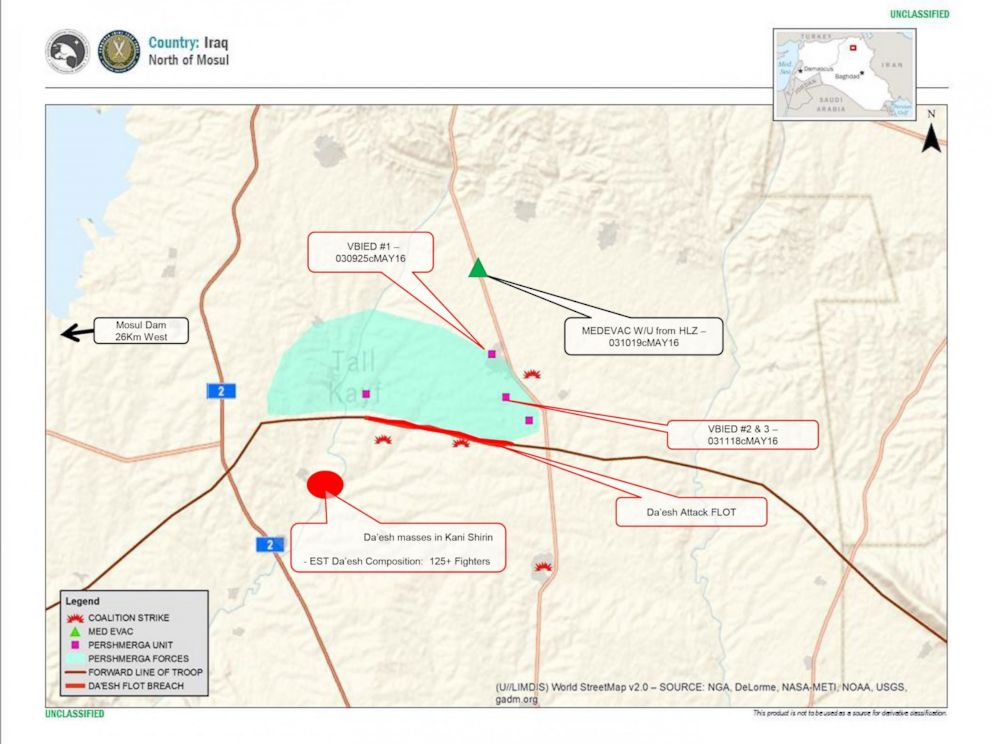Inside the Battle With ISIS That Killed a US Navy SEAL
The SEAL killed was part of a rescue force.
— -- The Navy SEAL killed in northern Iraq Tuesday was part of a reaction force sent to rescue a small team of American advisers who had joined in the fight to help Kurdish Peshmerga forces push back a large surprise ISIS assault to take the small town of Tel Skuf, north of Mosul.
Special Warfare Operator 1st Class Charles Keating IV, 31, of San Diego, was identified on Tuesday evening as the SEAL killed in the attack launched by 125 ISIS fighters.
Army Col. Steve Warren, the U.S. military spokesman in Baghdad, told Pentagon reporters today that the attack was the largest such ISIS assault in recent months. Thirty-one airstrikes called in to help repel the attack killed 58 ISIS fighters and destroyed more than 20 vehicles and trucks. Warren labeled Tuesday's fight as one of the most complex battlefield operations launched by ISIS since last December.
Warren said the attack on Tel Skuf fits the ISIS pattern of launching high-profile attacks to gain attention in the wake of a series of battlefield losses, as has happened recently with the Iraqi military pushing ISIS out of the towns of Hit, Bashir and Makhmur.
"When this enemy is on its heels, when it's suffered several setbacks, they're likely to try and lash out, you know, through terror attacks, perhaps in Baghdad, perhaps elsewhere in Syria, perhaps elsewhere in the world," Warren said. "It's part of the way this enemy operates, it's something that we know and it's something that we deal with.”

How the Attack Began
A small team of American advisers was on a mission to meet with local Kurdish Peshmerga forces at Tel Skuf, a village located just two miles north of the frontlines with ISIS. At 7:30 a.m. local time, a force of 125 ISIS fighters in more than 20 vehicles crossed the Kurdish frontlines and headed towards Tel Skuf. They used two bulldozers to get past a checkpoint and then used a truck bomb to attack the Peshmerga outpost that the American advisers were visiting.
Twenty minutes after the ISIS forces had crossed the frontline, the Americans began fighting alongside the Pesh forces to repel the attack. They also called for a Quick Reaction Force (QRF) that was standing by to come and take them away from the fighting. “There was a big fight," said Warren. "They couldn't get away. So the QRF came to help ensure that they were able to get away."
Navy SEAL Charlie Keating was a member of the quick reaction force that responded. He was struck by direct fire at 9:32 a.m. Though he was medevaced to a medical facility in Erbil, he did not survive his wounds.
There were no other American injuries, and it is unclear how many Pesh forces were injured. In another sign of how violent the firefight was, both Black Hawk medevac helicopters that arrived to evacuate Keating were damaged by small arms fire.
Eleven American fighters and bombers, including F-15s, F-16s, A-10s, and B-52s, as well as two drones, were quickly scrambled to push back the ISIS attack. Altogether, 31 airstrikes killed 58 ISIS fighters and destroyed 20 vehicles, two more truck bombs, three mortars, and a bulldozer.
The Americans were engaged in the fighting for a few hours, but the battle between Kurdish and ISIS forces continued until 9:30 p.m.




